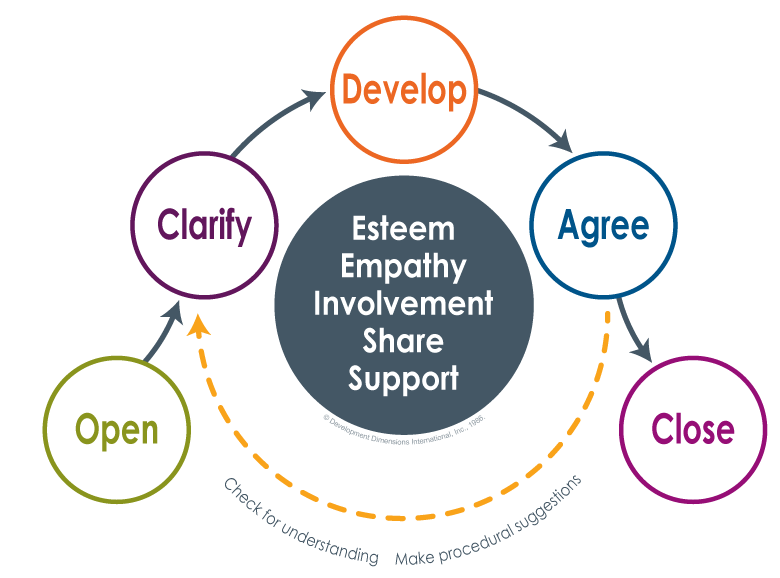As a leader, you will find yourself navigating a business landscape that demands speed, adaptability, and courage. You're faced with the challenge of balancing swift decision making with a need to initiate and engage in discussions on vital topics such as performance, profitability, and change management. These are important conversations, and let’s face it, they can sometimes feel tough.
No one could blame you if you felt like side-stepping some of the more challenging meetings, but the cost of doing so may be higher than you think. So, what if there was a way to embrace the difficulty and turn those moments of challenge into moments that matter, for everyone involved?
At the heart of your leadership journey lies the art of getting critical conversations right. It's through these conversations that you solve problems, provide feedback that fuels growth, and elevate your team and organization toward success. But how can you prepare for a critical conversation?
The Impact of Courageous Leadership on Business Results and Culture
Many leaders struggle to address the tough issues, especially when it comes to performance. We've all experienced difficult conversations that left us feeling uneasy. But avoiding challenging conversations perpetuates unresolved issues, leading to mounting tensions and detrimental consequences for company culture and business performance.
Some leaders make the mistake of delivering messages in a way that erodes trust and motivation. Their delivery may stem from a lack of self-awareness or, at times, laziness. How you deliver critical messages is just as crucial, if not more so, than the content itself.
People want leaders who truly care about their development and help them succeed. For leaders, this means overcoming the discomfort of a challenging conversation to help team members grow—and doing so in a way that elevates and empowers. And that doesn’t happen by accident.
At a time when engaging and motivating talent is so important—in 2022, 77% of employees were either unengaged or actively disengaged—it is every leader’s responsibility to level up their critical conversation skills.
3 Best Practices to Level Up Your Conversations at Work
Here are three best practices leaders can use to plan for conversations and ensure everyone leaves on the same page.

1. Know yourself: Are you focused on personal needs or practical needs?
During critical conversations, all parties bring their knowledge, personalities, experiences, preferences, and biases, which can influence the outcome—and should influence your approach. Understanding yourself can improve your ability to navigate the conversation.
Consider the difference between personal and practical needs. Personal needs refer to the "human" desire of every individual to be valued, heard, and supported. Practical needs refer to our desire for clarity and concrete outcomes.
You need to balance both types of needs during critical conversations. Most people find that they tune in more naturally to one type of need or the other.
If you are more comfortable considering personal needs, you are more naturally inclined to ensure that people feel respected, listened to, involved, and supported. However, you might not always address the hard issues and struggle to make decisions. You also might tend to leave interactions without clear outcomes and next steps.
If you are more comfortable considering practical needs, you focus on outcomes. However, you might not consistently involve others, listen to perspectives, or consider the personal impact of decisions on those involved. While on the surface it might feel like you are moving forward, you may face resistance, confusion, or frustration that can slow the process.
Ask yourself, do you gravitate most toward meeting personal needs or practical needs? What do you need to do to better meet both types of needs?

2. Consider and adapt to the person you’re speaking to.
Now ask yourself: How is the person I’m speaking to different than me?
Adapting to other people is like taking one step toward them. You’re much more likely to reach a positive outcome.
Is the person you’re speaking to tuned into practical needs or personal needs? How could you flex your natural style to meet their needs?

3. Choose the right time and place and be fully present.
Give yourself time to prepare and plan your approach.
Schedule a one-on-one meeting and set expectations about what you’ll discuss ahead of time. People are more likely to become defensive when they’re caught off guard.
Your message might sound like this: “I think we have different perceptions about this. Could we chat after 3 p.m. today to explore a solution that works well for both of us?”
Identify a private and neutral space where you both can focus, speak freely, and avoid distractions.
How to Engage the Heart and Mind at Each Stage of a Conversation
Leaders can use the Interaction EssentialsSM in their day-to-day interactions at work. The following five steps provide a framework to prepare key messages to achieve the objectives of the conversation (practical needs) and consider how to engage the heart and mind at every step, ensuring people feel valued, understood, supported, and respected (personal needs).

1. Open: Clearly describe the purpose of the discussion and explain why it's important.
2. Clarify: Seek and share information about the situation. This step is often skipped, but remember that you may not have the full picture. Be curious about the situation and listen with empathy.
If you demonstrate understanding of the context elements, people are more likely to trust your intention. Overcome resistance by sharing data to support your perspective:
- “I can see this caught you off guard. Why don’t I share the survey data, and we can discuss how to address the problem?”
Watch this step carefully if you are on the practical side of the continuum.
3. Develop: Use your understanding of the situation to seek and discuss ideas. Explore needed resources and support.
It is often useful to involve others to share their ideas and suggestions before offering your own. Involving people sparks their creative energy and can generate better ideas. But most importantly, when you involve others in the ideation, they will be more committed to putting their own ideas into action. Overcome resistance by sharing your own experience:
- “What am I supposed to do now? I’ve never dealt with this before.”
- “The first time this happened to me, it was a real blow to my confidence, but it helped me grow. Let’s come up with ways to mitigate the issues.”
4. Agree: Ensure understanding and agreement of who will do what and by when. If you end the discussion without agreeing on actions, you risk people leaving the discussion unclear about what to do next. Confirm how to track progress and offer support. Watch this step carefully if you are on the personal side of the continuum.
5. Close: The closing gives you a chance to briefly summarize what was discussed and agreed to. This helps ensure commitment to actions as well as builds both parties’ confidence and esteem in achieving the plan.
Critical Conversations Done Right Drive Engagement
In a world that thrives on agility, it is more crucial than ever to handle critical conversations with courage and finesse. It's not enough for leaders to solely drive toward results—they must balance tangible outcomes with emotional intelligence that drives engagement.
What is one small step you can take to level up your critical conversations and elevate your team towards success?
Capucine Loisance is an occupational psychologist and ICF-certified coach, leading a team of consultants for DDI Europe. She collaborates with multinationals, defining talent strategies and coaching international groups of leaders. Capucine also has a passion for exploring vineyards and savoring local delicacies across the globe. Connect with Capucine on LinkedIn.
Learn how to help your leaders build trust with their teams in our on-demand webinar, Building a Culture of Trust.
Topics covered in this blog

